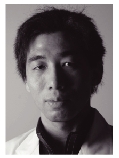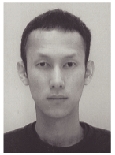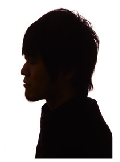

( 日本語版 )
|
"Touch the Invisibles" is an interface for connecting digital and real worlds. This interface is composed of
nail-mounted tactile interface and bubble. |
|
Nail-mounted Tactile Interface |
|
We usually perceive surface by finger movements. The information from the finger pad is used for surface recognition. However, when the vibration is presented from the NAIL during the finger movement, the vibration can also be perceived as the stimulus from the FINGER PAD, instead of the stimulus from nail. Ando, Miki, Inami, Maeda, SmartFinger: "Nail-Mounted Tactile Display" Emerging Technologies SIGGRAPH 2002 |

|
The vibrator (voice coil) is attached to the nail with the double sticky tape. When the finger position is measured and the vibration is presented according to the relative position of the finger and the visual images, the user can touch the visual images even on the smooth surface such as computer display monitor.
Using this interface, any kind of visual information can be presented with real time tactile feedback. For example, we can perceive the bump for black areas on the flat computer monitor. |

|
Bubble-log |
|
How humans act can be recorded in objects such as footprints and animal trails in the natural world. Even though these objects cannot describe a precise information of the action, their beauty can impress us. The history of operations in the digital world however, is expressed as series of 0/1 information.
Considering deep relationships between the human and digital world in modern society, the history in the digital world should be recorded in a more appealing way. Here we propose “Bubble-log,” which can express changes in the digital world and transform it into natural objects. |

| We chose bubbles for the material of natural objects due to their interesting plasticity. As air is brought into the water, bubbles are piling up at the position. Therefore spatial differences of the information operation can be visualized in the geometry of the bubbles in the chassis. The bubbles change as time goes by and they get influenced by the history of operation. In addition, bubbles are generated with natural providence and therefore, even the same digital information is expressed in unique objects. |

|
History |
|
2009 2/4-15 12th Japan Media Arts Festival in 2009 (Excellence Prize, in Art division) 2009 8/3-7 SIGGRAPH2009 Information Aesthetics Showcase 2009 8/28-30 Good Design Expo 2009 2009 10/30-11/3 DESIGNTIDE TOKYO 2009 |
Press Kit (PDFdocument and photos)
|
Junji Watanabe (JPN) |
|
 |
He was born in 1976. He graduated from Department of Mathematical Engineering and Information Physics, School of Engineering, the University of Tokyo in 2000, and received his Ph. D. in Information Science and Technology from the University of Tokyo in 2005. He studies cognitive science, and its applications to communication devices and artistic expressions. His research has been performed not only from an academic viewpoint but also through creative activities in collaboration with artists and designers. |
|
Eisuke Kusachi (JPN) |
|
 |
He was born in Japan in 1978. He had studied information design, and media art at Tama Art University, and received M.A. in Information Design. He works as artist and received awards in area of Media Arts. His art work "Slot Machine Drawing" was exhibited in Japan Media Arts Festival 2007, and in Ars Electronica Center 2007-2008. He also received Excellence Prize at Japan Media Arts Festival 2008. |
|
NOSIGNER |
|
 |
The word "design" originates from the Latin word "designare" meaning de-sign. On the other
hand, "nosign" means no-sign which has no signature on it. Nosigner is somebody who designs invisible thing without explicit signature. |
|
Hideyuki Ando (JPN) |
|
 |
He was born in 1974, and completed his master's course at the Graduate School of Engineering, Aichi Institute of Technology, in 1999. In 2000 he worked as a junior research assistant at RIKEN's Bio Mimetic Control research center. In 2001 he worked as a researcher at The University of Tokyo Interfaculty Initiative in Information Studies as a member of the former Japan Science Technology Corporation's 'harmony and control' project. From 2002 he was a research associate, and from 2007 a research specialist, at NTT Communication Science Laboratories. He is currently an associate professor at the Graduate School of Information Science and Technology, Osaka University. |
|
(c) Junji Watanabe, Eisuke Kusachi, NOSIGNER,
Hideyuki
Ando 2009
All photographs of the interface and title photo (c) Hatta |